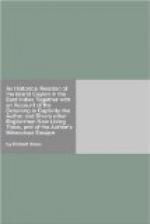[Their drink and manner of eating.] Their common drink is only water: and if they drink Rack, it is before they eat, that it may have the more operation upon their bodies. When they drink they touch not the Pot with their mouths, but hold it at a distance, and pour it in. They eat their Rice out of China dishes, or Brass Basons, and they that have not them, on leaves. The Carrees, or other sorts of Food which they eat with their Rice, is kept in the Pans it is dressed in, and their wives serve them with it, when they call for it. For it is their duties to wait and serve their Husbands while they eat, and when they have done, then to take and eat that which they have left upon their Trenchers. During their eating they neither use nor delight to talk to one another.
[Their manner of washing before and after meals.] They always wash their hands and mouths both before and after they have eaten; but for others to pour the water on their hands is looked upon as an affront. For so they do to them, whom they account not worthy to handle their Water pot. But when they wash, with one hand they pour it themselves upon the other. They are very cleanly both in their bodies and heads, which they do very often wash, and also when they have been at stool they make use of water.
[None must speak while the Rice is put into the Pot.] But to give you a little of their Cookery. If People be in the room talking together, the woman being ready to put the Rice into the Pot, bids them all be silent till she has put it in, and then they may procede with their discourse. For if they should talk while the Rice is putting in, it would not swell.
[Sawce made of Lemmon juyce.] At the time of the year that there is most plenty of Lemmons, they take them and squeez the juyce into an earthen Pot, and set over the fire, and boil it so long, till it becomes thick and black like Tar. This they set by for their use, and it will keep as long as they please. A very small quantity of it will suffice for sawce. They call it Annego.
[Their sweet meats.] They have several sorts of sweet-meats. One they call Caown. It is like to a Fritter made of Rice-flower, and Jaggory. They make them up in little lumps, and lay them upon a Leaf, and then press them with their thumbs, and put them into a Frying-Pan, and fry them in Coker-nut Oyl or Butter. When the Dutch came first to Columba, the King ordered these Caown to be made and sent to them as a royal Treat. And they say, the Dutch did so admire them, that they asked if they grew not upon Trees, supposing it past the Art of man to make such dainties.
Oggulas another sort of sweet-meats, made of parched Rice, Jaggory, Pepper, Cardamum, and a little Cinnamons. They rowl them up in Balls, which will grow hard. These they tie up in bags and carry them with them when they travail to eat in afternoons when they are hungry.
Alloways made much after the former manner, only they are flat in the fashion of a Lozenge; which are good for faintings and thirsty souls to relish their water, and to eat of in afternoons when they are at home. We carried some of these along with us in our travayl.




